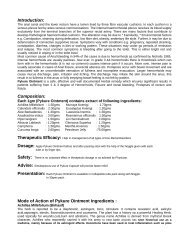You also want an ePaper? Increase the reach of your titles
YUMPU automatically turns print PDFs into web optimized ePapers that Google loves.
<strong>Spices</strong> <strong>Grounded</strong> (<strong>Powder</strong>)<br />
Presenting grounded(<strong>Powder</strong>)spices that enhance the flavor of every cuisine. <strong>Spices</strong> are indispensable in culinary art, contributing<br />
their distinct aroma,taste, flavor and color. Some of these spices are used as appetizers, others as preservatives and<br />
still others are taken as a digestive.products.Many of them are rich in medicinal properties and are used in<br />
pharmaceutical, perfumery and cosmetic products.<br />
Packaging<br />
We have been able to carve a niche for ourselves in the industry with our ability to customize our products & product<br />
packaging. We ensure customized packaging as per our client's requirement and meet the stipulated time frame. We<br />
customize the packaging according to our clients' specification based on:<br />
Product Quantity ( Consumer packing = 50gms to 5kgs;100gms(3.5oz),200gms(7oz),400gms(14oz),1kgs(2lbs3oz),5kgs(11lbs)//<br />
Bulk packing = 20kgs(44lbs) , 25kgs(55lbs), 50kgs(110lbs. ):<br />
Type of Packaging (packed in poly-packs, jute bags, paper boxes, etc.)<br />
Packaging According to the market being catered to. (varying environmental conditions, time in transit, etc.)<br />
Standardized packaging material are used by us that retains fragrance, property and extends higher shelf life of all<br />
products.<br />
<strong>Spices</strong> <strong>Grounded</strong> (<strong>Powder</strong>)<br />
DESCRIPTION DESCRIPTION<br />
Ajwain Sheeds (Celery Seeds ) Fenugreek (Methi)<br />
Anardana (Pomegranate seed) Fenugreek (Methi) Dried Leaves<br />
Basil Seeds ( Sabja) Ginger Whole ( Bleached/Unbleached )<br />
Bay leaves Dry (Tej Patta) Green Cardamom (Elichi)<br />
Black Cardamom (Black Elichi)<br />
Jawantry ( Mace) Whole<br />
Black Kokum Lucknow Fennel<br />
Black Pepper MG-1/TGEB/TGSEB Mustard (Rai) Small / Big<br />
Black Pepper Mustard Seeds Yellow/Black<br />
Cardamom ( Elaichi) Nigella Seeds (Magral)<br />
Cardamom Seeds Nutmeg ( Jaiffur)<br />
Charoli Pepper Dried<br />
Char Magez Poppy Seeds (Khus Khus)<br />
Cinnamon Stick (Dalchini) Red Chilly Whole Stemless<br />
Cloves ( Lovang) Sabudana (Sago)<br />
Coriander (Indori / Kanpuri ) Samo Seeds / Kodri Seeds<br />
Cumin (Jeera) & (Shahi Jeera) Sesame (Till) Black 98:2<br />
Curry Leaves ( Dry) Sesame (Till) Hulled White<br />
Dhaniadal Roasted Brown/Yellow Sesame (Till) Natural 98:2<br />
Dill Seeds (Suva) Star Anise (starfool)<br />
Dried Apricot (Jardalu) Tamarind ( Emili)<br />
Dry Mango Slices (Make Amchur)<br />
<strong>Powder</strong> <strong>Powder</strong><br />
Turmeric Fingers ( Haldi)<br />
Fennel (Saunf) White Pepper Whole<br />
Fennel Roasted<br />
<strong>Spices</strong> Ground (<strong>Powder</strong>)Commercial Packing<br />
DESCRIPTION PACKING DESCRIPTION PACKING
<strong>Powder</strong> <strong>Powder</strong><br />
Amchur <strong>Powder</strong> 5 &25 kg Hdpe/Jute Dessicated Coconut <strong>Powder</strong> 5 &25 kg Hdpe/Jute<br />
Anardana <strong>Powder</strong> 5 &25 kg Hdpe/Jute Dhana-Jeera <strong>Powder</strong> 5 &25 kg Hdpe/Jute<br />
Black Pepper <strong>Powder</strong> 5 &25 kg Hdpe/Jute Fenugreek (Methi) <strong>Powder</strong> 5 &25 kg Hdpe/Jute<br />
Chilly <strong>Powder</strong> Coarse 5 &25 kg Hdpe/Jute Garam Masala <strong>Powder</strong> 5 &25 kg Hdpe/Jute<br />
Chilly <strong>Powder</strong> Fine 5 &25 kg Hdpe/Jute Ginger <strong>Powder</strong> 5 &25 kg Hdpe/Jute<br />
Coriander <strong>Powder</strong> 5 &25 kg Hdpe/Jute Madras Curry <strong>Powder</strong> 5 &25 kg Hdpe/Jute<br />
Crushed (Pizza) Chilly 5 &25 kg Hdpe/Jute Methi Kuria / Rai Kuria 5 &25 kg Hdpe/Jute<br />
Cumin (Jeera) <strong>Powder</strong> 5 &25 kg Hdpe/Jute Pickle Mix Masala (Mangal) 5 &25 kg Hdpe/Jute<br />
Curry <strong>Powder</strong> HOT / MILD 5 &25 kg Hdpe/Jute Turmeric <strong>Powder</strong> 5 &25 kg Hdpe/Jute<br />
<strong>Spices</strong> Whole & Ground(<strong>Powder</strong>)<br />
Send enquiry<br />
DESCRIPTION PACKING DESCRIPTION PACKING<br />
<strong>Powder</strong> <strong>Powder</strong><br />
Bay leaves (Tej Patta) 25 kg Hdpe/Jute Anardana (Pomegranate seed) 25 kg Hdpe/Jute<br />
Black Cardamom (Elcha) 25 kg Hdpe/Jute Anardana <strong>Powder</strong> 25 kg Hdpe/Jute<br />
Black Kokum 30 kg Case Black Pepper <strong>Powder</strong> 25 kg Hdpe/Jute<br />
Black Pepper MG-1/TGEB/TGSEB 25 kg Hdpe/Jute Char Magez 25 kg Hdpe/Jute<br />
Coriander (Indori / Kanpuri ) 25 kg Hdpe/Jute Chilly <strong>Powder</strong> Coarse 25 kg Hdpe/Jute<br />
Cumin (Jeera) 25 kg Hdpe/Jute Chilly <strong>Powder</strong> Fine 25 kg Hdpe/Jute<br />
Dhanadal Roasted Brown/Yellow 25 kg Hdpe/Jute Coriander <strong>Powder</strong> 25 kg Hdpe/Jute<br />
Dill Seeds (Suva) 25 kg Hdpe/Jute Crushed (Pizza) Chilly 25 kg Hdpe/Jute<br />
Fennel (Saunf) 25 kg Hdpe/Jute Cumin (Jeera) <strong>Powder</strong> 25 kg Hdpe/Jute<br />
Fennel Roasted 25 kg Hdpe/Jute Curry <strong>Powder</strong> HOT / MILD 25 kg Hdpe/Jute<br />
Fenugreek (Methi) 25 kg Hdpe/Jute Dessicated Coconut <strong>Powder</strong> 25 kg Kraft Paper<br />
Ginger Whole Bleached/Unbleached 25 kg Hdpe/Jute Dhana-Jeera <strong>Powder</strong> 25 kg Hdpe/Jute<br />
Jawantry (Mace) Whole 17 Kg Carton Dried Apricot (Jardalu) 20 Kg Ctn<br />
Kokum Phool 40 kg Bag Fenugreek (Methi) <strong>Powder</strong> 25 kg Hdpe/Jute<br />
Lucknow Fennel 25 kg Hdpe/Jute Garam Masala <strong>Powder</strong> 25 kg Hdpe/Jute<br />
Mustard (Rai) Small / Big 25 kg Hdpe/Jute Ginger <strong>Powder</strong> 25 kg Hdpe/Jute<br />
Poppy Seeds (Khus Khus) 25 kg Hdpe/Jute Madras Curry <strong>Powder</strong> 25 kg Hdpe/Jute<br />
Red Chilly Whole Stemless 25 kg Hdpe/Jute Methi Kuria / Rai Kuria 25 kg Hdpe/Jute<br />
Sabudana (Sago) 25 kg Hdpe/Jute Pickle Mix Masala (Mangal) 25 kg Hdpe/Jute<br />
Sesame (Till) Hulled White 25 kg Hdpe/Jute Samo Seeds / Kodri Seeds 25 kg Hdpe/Jute<br />
Sesame (Till) Natural 98:2 25 kg Hdpe/Jute Turmeric <strong>Powder</strong> 25 kg Hdpe/Jute<br />
Send enquiry<br />
Cinnamon stick is basically the bark of a tree and is used as a spice in Indian fooddue to its distinct<br />
fragrance. We offer the finest quality cinnamon which is afragrance enhancer of any food item in<br />
the Indian cuisine.<br />
<strong>Spices</strong> <strong>Powder</strong> Photo & Detail<br />
Cinnamon Stick (Dalchini)<br />
Cinnamon does not only taste good, it also contains many health benefits such as: Anti-Clotting and<br />
Anti-Microbial actions, Blood Sugar Control, it boosts Brain Function, it's Calcium and Fiber protect<br />
against Heart Disease and improve Colon Health, among other things<br />
Cinnamon’s unique healing abilities come from three basic types of components in the essential<br />
oils found in its bark. These oils contain active components called cinnamaldehyde, cinnamyl<br />
acetate, and cinnamyl alcohol, plus a wide range of other volatile substances<br />
Ajwain <strong>Powder</strong> (Celery <strong>Powder</strong> )<br />
What is Ajwain? – Ajwain is a herb also known as Bishops Weed. This beneficial herb is used in<br />
culinary process as spice as well as a major ingredient of different kind of medicines.Ajwain seeds<br />
are small in size but taste hot, penchant and bitter. It acts as good appetizer,laxative and stomachic.<br />
It is used as effective remedy in managing ailments like vomiting, mouth diseases, pile, treatment<br />
of ascites, abdominal tumor, abdominal pain etc…………….
Anardana (Pomegranate <strong>Powder</strong>)<br />
Anardana is the name for a culinary spice made from the dried seeds and pulp of some<br />
varieties ofpomegranate fruit (Punica granatum) that are too sour to eat fresh. The wild<br />
pomegranates, known as daru and grown in the southern Himalayas, are believed to yield the<br />
highest quality seeds for making the sticky spice, though it is also made from cultivated fruit.<br />
Wild pomegranates are preferred, however, as they can be grown easily with almost no care or<br />
maintenance until the fruits are ready to be harvested. The small pomegranate fruits reach a<br />
diameter of only 2.5 inches (6.35 Cm) with a hard outer rind and dark red to pinkish-white seeds.<br />
Basil Seeds ( Sabja)<br />
Basil Seeds also known as Tukmaria seeds (SABJA) Ocimum basilicum Tukmaria seeds (Basil<br />
Seeds) (SABJA) are commonly used when making Falooda (Vermicelli) drinks. The seeds float at<br />
the bottom and are absolutely delicious. Falooda or Faluda : is a popular beverage in the Indian<br />
subcontinent made primarily by mixing rose syrup with vermicelli and tapioca seeds/sabja seeds<br />
along with either milk or water. how they grow Sabja seeds grow on a variety of basil plant. This is<br />
found wild all over India and has dark green leaves and a branched erect stem. The plant grows to<br />
a height of 1m.The flowers grow in slender spike and give way to tiny seeds.These dry on the plant<br />
or are dried in the sun. When dropped into water they first develop a whitish grey bloom and then<br />
the skin swells appearing hurry. The outer coating is translucent and pale grey so the black seed<br />
within can be easily seen. Once they get to this stage they are ready to be eaten. They have no<br />
aroma or taste but a strange pleasant combination of contrasting textures. Health benefits: Sabja<br />
seeds are considered to be diuretic tonic and an excellent remedy for constipation and piles.<br />
The plant is recommended for coughs worms and stomach complaints and the juice of the leaves<br />
is applied externally for skin disorders. Sabja seeds reduces body heat: Sabja seeds are the best<br />
known substance that reduces body heat. These seeds are soaked in water for sometime and<br />
added to milk with rose syrup. This is a good drink to cool down your system instantly.<br />
Bay leaves Dry (Tej Patta <strong>Powder</strong>)<br />
Commonly known as Tej patta. They are literally leaves which have a typical strong aroma.<br />
Bay leaves are used in dried form. Generally used in curries and rice preparations. Bay Leaves<br />
are a constituent of the 'Garam Masala are aromatic leaves. Fresh or dried bay leaves are used in<br />
cooking for their distinctive flavor and fragrance. The leaves are often used to flavor soups,<br />
stews, braises , Indian Curries and all varieties of Rice. Vegetable and Chicken Biryani cannot be<br />
complete without Bay Leaves in it.<br />
Marati Moggu <strong>Powder</strong><br />
Moggu is a spice used in some of Karnataka's cherished dishes such as bisibele bhath, saagu,<br />
(Karnataka style) kootus to name a few. It is brownish in color and looks somewhat like a bigger<br />
version of a clove. I had failed to notice that it smells somewhat like shikakayi powder until today.<br />
The smell / fragrance attached to it is not that strong that one would notice it as soon as a container<br />
of moggu is opened and I guess that's the reason I missed it. (For those shampoo lovers and who<br />
hair). It is not eaten raw but always dry fried and ground with other spices before going into a dish.<br />
don't know what it is, shikakayi powder is used in India to wash<br />
it is called moggu in Kannada and mogga in Telugu which literally means a bud. Since the<br />
Kannadigas attach the tag Maratha, I am assuming it is used in Maharasthrian<br />
cuisine as well. I always get my supply of moggu from India since I could not<br />
find this in any Indian grocery shops here.<br />
Kalpasi <strong>Powder</strong><br />
Kalpasi, also known as "Black Stone Flower" or Dagad Phool is a rare dried flower used often<br />
as an Indian spice in Chettinad. Its latin name is Didymocarpus Pedicellatus, in the family<br />
Gesneriaceae. Some of the other names for it include Shaileyam in Sanskrit / Gokshura, Jeevanti<br />
in Hindi, Kallupachi in Telugu.
Black Cardamom (Black Elichi) <strong>Powder</strong><br />
Black cardamom (also known as brown cardamom, elaichi, is a plant in the family<br />
Zingiberaceae. Its seed pods have a strong camphor-like flavor, with a smoky character derived<br />
from the method of drying.The pods are used as a spice, in a manner similar to the green Indian<br />
cardamom pods, but those have a drastically different flavor. Unlike green cardamom, this spice is<br />
rarely used in sweet dishes. Its smoky flavor and aroma derive from traditional methods of drying<br />
over open flames. It is also called badhi elaichi in Hindi.<br />
Black Cardamom <strong>Powder</strong> (Black Elichi)<br />
There are at least two distinct species of black cardamom: Amomum subulatum (also known<br />
as Nepal cardamom) and Amomum costatum or A. tsao-ko. The pods of A. subulatum, used<br />
primarily in the cuisines of India, are the smaller of the two, while the larger pods ofA. Costatum<br />
are used in Chinese cuisine, particularly that of Sichuan; and Vietnamese cuisine<br />
In India and Pakistan, black cardamom seeds are often an important component of the Indo-<br />
Pak spice mixture garam masala. Black cardamom is also commonly used in savory dal and rice<br />
dishes. In Tamil it is called as Maratti mokku In Manipuri, it is called Elaichi Achouba. In India and<br />
Pakistan this is used in making traditional tea(chai)<br />
Black Kokum<br />
Also known as black kokum, cocum, and kokam, kokum is a small round fruit that has its origins in<br />
India. As atropical fruit that is grown on an evergreen variety of trees, kokum is usually dark purple<br />
to black in color, and normally does not have a diameter of more than two inches. An outer rind<br />
sweet and salty.protects the meat of the fruit, which as a taste that is both<br />
Kokum is unique in that both the rind and the pulp of the fruit can be used in several ways.<br />
The meat of thekokum fruit is considered to be an ideal snack when cut into small pieces. As a<br />
seasoning, the rind and the pulp are often dried and then pulverized into a powder. The mixture<br />
of sour and sweet taste is considered a nice addition to a number of different dishes, both hot and<br />
cold. Curry dishes are often created with the use of thekokum powder, as are bean and vegetable<br />
dishes. The powder is added during the preparation of the dish in most cases. However, it is not<br />
unusual for kokum to be added to the completed dish, in a manner similar to using salt and<br />
pepper at the dinner table.<br />
Black Pepper MG-1/TGEB/TGSEB<br />
Black pepper is produced from the still-green unripe drupes of the pepper plant. The drupes are<br />
cooked briefly in hot water, both to clean them and to prepare them for drying. The heat ruptures<br />
cell walls in the pepper, speeding the work of browning enzymes during drying. The drupes are<br />
dried in the sun or by machine for several days, during which the pepper around the seed shrinks<br />
and darkens into a thin, wrinkled black layer. Once dried, the spice is called black peppercorn.<br />
Black peppercorn is considered spicier than white peppercorn.<br />
Black Pepper MG-1/TGEB/TGSEB<br />
Black pepper is produced from the still-green unripe drupes of the pepper plant. The drupes are<br />
cooked briefly in hot water, both to clean them and to prepare them for drying. The heat ruptures<br />
cell walls in the pepper, speeding the work of browning enzymes during drying. The drupes are<br />
dried in the sun or by machine for several days, during which the pepper around the seed shrinks<br />
and darkens into a thin, wrinkled black layer. Once dried, the spice is called black peppercorn.<br />
Black peppercorn is considered spicier than white peppercorn.<br />
Cardamom ( Elaichi)<br />
Cardamom pods contain fragrant seeds, used throughout the world in both savory and sweet dish<br />
Many Indian meat, rice and dessert dishes use cardamom as one of the main spices. Cardamoms<br />
are also essential parts of spice mixtures such as Garam Masala.<br />
Beside India and south Asia, cardamom is also use in Scandinavian food such cakes, pastry,<br />
Pickles and also used in middle east. Cardamoms are perennial bush that flourishes in warm<br />
temperatures like that in South India. Around eighty percent of world cardamoms are produced in India.<br />
Also spelled as Ilayachi.
Cardamom pods contain fragrant seeds, used throughout the world in both savory and sweet dish<br />
Many Indian meat, rice and dessert dishes use cardamom as one of the main spices. Cardamoms<br />
are also essential parts of spice mixtures such as Garam Masala.<br />
Beside India and south Asia, cardamom is also use in Scandinavian food such cakes, pastry,<br />
Pickles and also used in middle east. Cardamoms are perennial bush that flourishes in warm<br />
temperatures like that in South India. Around eighty percent of world cardamoms are produced in India.<br />
Also spelled as Ilayachi.<br />
Charoli are the seeds of a Buchanania lanzan or almondette tree, which is native to India, Malaysia,<br />
and other parts of Asia. They usually resemble small beans or peas. These seeds are often<br />
crushed to create a powder that is then used as a flavoring or spice in many authentic Indian<br />
dishes. It might also be used in traditional systems of natural medicine that are normally practiced<br />
in these parts of the world.<br />
Cardamom Green( Elaichi)<br />
Charoli<br />
The almondette tree usually grows in tropical climates that have a very rainy or monsoon period<br />
in the spring. They can sometimes grow to a height of around 49 feet (15 m) in height. The plant<br />
typically has large round or oval-shaped leaves that are commonly light green with splotches of<br />
brown or yellow. This tree occasionally has long white flowers that eventually produce the charoli.<br />
Charoli seeds are normally around 1/2 inch (1.3 cm) long. They are mostly round in shape, and<br />
can sometimes be flat on one side. These nuts are usually medium or light brown in color, but are<br />
also occasionally black on the outside. They are typically contained inside a shell that is very hard<br />
and difficult to crack, however, the fruit inside is usually very soft and tender.<br />
Char Magez <strong>Powder</strong><br />
The melon is a member of the Cucurbitaceae family with its characteristic fleshy fruits.Thought<br />
to be originally from the Middle Eastern region, the melon seeds were transported to the<br />
Americas by Columbus and the Spanish explorers. In India, time.Being lower in calories and<br />
having high water content, the melon is a refreshingand healthy food. The melon seed is<br />
generally, a grayish white hard shell with a white inner kernel, which is soft and oval in shape.<br />
The seeds of the melon arerich in protein, omega-3 fatty acids, vitamins, fats and other nutrients.<br />
It lacks any distinct scent but has a nutty and sweet taste.<br />
Cloves can be used in cooking either whole or in a ground form, but as they are extremely strong,<br />
they are used sparingly.loves have historically been used in Indian cuisine (both North Indian and<br />
South Indian). In North Indian cuisine, it is used in almost all rich or spicy dishes as an ingredient<br />
of a mix named garam masala, along with other spices, although it is not an everyday ingredient for<br />
home cuisine, nor is it used in summer very often. In the Maharashtra region of India it is used<br />
sparingly for sweet or spicy dishes, but rarely in everyday cuisine. InAyurvedic medicine it is the<br />
difference of usage by region and season. In south Indian cuisine, it is used extensively in biryani<br />
along with "cloves dish" (similar to pilaf, but with the addition of other spices), and it is normally<br />
added whole to enhance the<br />
Cloves ( Lovang) <strong>Powder</strong><br />
Coriander (Indori / Kanpuri )<strong>Powder</strong><br />
Coriander is a spice made from the seed of the Cilantro plant. The plant, which is also called the<br />
Corianderplant or Chinese Parsley, is a member of the carrot and parsley family. The seeds are<br />
small and round, with a brown or yellowish-brown color.<br />
Both the seeds and leaves of the Cilantro plants are edible, but they have very distinct flavors and<br />
uses.Coriander has a light and fresh flavor, tinged with lemon. It is commonly used in curries<br />
or in other Asian cuisines and is often combined with ginger. Coriander is also used to flavor<br />
sausages and is even used in manufacturing some cigarettes. Cilantro leaves have a very pungent<br />
flavor; people generally love or hate the taste of Cilantro.
The Cilantro plant has been grown in India, China and Egypt for thousands of years. Coriander is<br />
believed to be one of the earliest spices used by man. There are references to the spice in early<br />
Sanskrit documents, the Bible and ancient Chinese and Middle Eastern stories. It gained an early<br />
More recently, it has gained popularity in Western and Southwestern cuisine. Today, Spain and<br />
Morocco are some of the leading producers of coriander.<br />
Cumin is the second most popular spice in the world after black pepper. Cumin seeds are used<br />
as a spice for their distinctive aroma, popular in Indian, Pakistani, North African, Middle<br />
Eastern, Sri Lankan, Cuban, northern Mexican cuisines, central AsianUzbek cuisine, and the<br />
western Chinese cuisines of Sichuan and Xinjiang. Cumin can be found in some Dutch cheeses,<br />
such as Leyden cheese, and in some traditional breads from France. It is commonly used<br />
in traditional Brazilian cuisine. Cumin can be an ingredient in in achiote blends, adobos, sofrito,<br />
garam masala, curry powder, and bahaarat<br />
Cumin seeds are earthy, aromatic flavor, which is slightly bitter but not hot. It gives an earthy<br />
aroma when ground. It can be used with pulses and beans and is an integral part of curry making.<br />
Most of the Indian traditional dishes are spiced with cumin seeds. Our cumin seeds are cleaned<br />
carefully and all the extraneous material is removed after plucking of theseeds, before th actual<br />
processing.<br />
Coriander (Indori / Kanpuri )<strong>Powder</strong><br />
Cumin (Jeera) <strong>Powder</strong><br />
Curry Leaves ( Dry) <strong>Powder</strong><br />
Regarding curry leaves I live in the western coast of southern India. Typical to any humid tropical<br />
region we get plenty of rains during monsoon and bright Sun round the year. The soil is mostly<br />
sublaterate which is not very good for gowing anything except Coconuts and Banana.<br />
Dhaniadal Roasted Brown/Yellow <strong>Powder</strong><br />
Coriander seed is a spice (Hindi name: धनया dhania), in garam masala and Indian curries,which<br />
often employ the ground fruits in generous amounts together with cumin. It acts as a thickener.<br />
Roasted coriander seeds, called dhana dal, are eaten as a snack. It is the main ingredient of the<br />
two south Indian dishes: sambhar and rasam . Coriander seeds are boiled with water and drunk<br />
as indigenous medicine for colds.<br />
Dill Seeds (Suva) <strong>Powder</strong><br />
Fruit and dried leaves, often called dill weed, are also used as herbs, because they are aromatic<br />
and are used to flavor many dishes, soups, pickles and medicines. Dillseeds are do their best<br />
when they are used fresh and that is why some times dill seeds are frozen anddried to preserve<br />
their flavor for a few months. Dill oil is also used for various purposes.<br />
Dried Apricot (Jardalu)<br />
Cyanogenic glycosides (found in most stone fruit seeds, bark, and leaves) are found in high<br />
concentration in apricot seeds. Laetrile, a purportedalternative treatment for cancer, is extracted from<br />
apricot seeds. Apricot seeds "were used against tumors as early as A.D. 502. In Englandduring<br />
the seventeenth century, apricot oil was also used against tumors, swellings, and ulcers".[14]<br />
In 2005, scientists in the Republic of Koreafound that treating human prostate cancer cells<br />
amygdalin may offer a valuable option for the treatment of prostate cancers.[15]
Dry Mango Slices (Make Amchur)<br />
Amchur is an Indian spice made from the flesh of dried green mangos. It preserves the acidic,<br />
tart, and slightly spicy flavor of unripe mangos for use in curries and other dishes. Amchur is<br />
available in whole and powdered forms in Indian specialty stores, as well as grocery stores in<br />
areas with a large Indian community. It can be used in a wide assortment of ways, and will lend<br />
an authentic flavor to many Indian dishes. A little bit of the spice goes a long way, so cooks should<br />
remember to use amchur in moderation.<br />
The mango is an evergreen tropical tree, Mangifera indica, native to Southern Asia. Numerous<br />
varietals of the tree are cultivated, and all of them produce roughly oblong smooth skinned<br />
fruits with large pits. Mangoes have been cultivated for use in Indian and Southeast Asian<br />
cuisine for thousands of years. When well cared for, the trees will live and produce fruit for<br />
decades. The culinary traditions of many nations include mango in a variety of forms as a<br />
result of the ready availability of the ingredient. Ripe and unripe mangos are used fresh or<br />
preserved, with condiments such as mango pickle being very popular, especially in India.<br />
Fennel plant is a small herb which grows through out the year. The fennel seeds are very popularly<br />
used as mouth freshener, also put in tooth paste for a fresh breathe not just the seeds, its leaves<br />
can be boiled also used in medical field for various purposes, and is cooked in many forms, it is<br />
cooked, marinated or cleaned and are carefully packed to restore aroma,we also provide many<br />
flavors that suit different needs.<br />
Fennel Roasted<br />
Fenugreek (Methi)<br />
We provide superior quality Fenugreek Methi Seeds in the market. We are one of the reputed<br />
Fenugreek Seeds Manufacturers and Suppliers. Our Fenugreek Seeds are accessible in different<br />
varieties. These seeds are known of excellent crop yield as well. Besides,we are also one of the<br />
reliable Methi Seeds Exporters from India.<br />
Fenugreek is a native to India and southern Europe. For centuries it has grown wild in India,<br />
the Mediterranean and North Africa. where it is mainly cultivated. A limited crop grows in France.<br />
It was used by the ancient Egyptians to combat fever and grown in classical times as cattle fodder.<br />
Commercially, it is used in the preparation of mango chutneys and as a base for imitation maple<br />
syrup. In India it is used medicinally, and as a yellow dyestuff. It is also an oriental cattle fodder<br />
and is planted as a soil renovator. In the West, fenugreek’s therapeutic use is now largely confined<br />
to the treatment of animals<br />
Fennel Roasted<br />
Remove the outer leaf or two from your fennel bulbs (they may be a little tough). Trim off any stalks<br />
which are still attached. Slice the bulb into thin wedges (maximum 2cm wide) as if cutting a cake.<br />
The layers of each wedge should be held together by the base of the bulb.<br />
In a glass, mix up melted butter, olive oil, salt and freshly ground pepper. Generously baste the<br />
wedges on both sides with this mixture. Lay the wedges on a tray lined with alfoil and cook at 200C<br />
for 20 minutes, turning once (using tongs makes this easier). If the wedge looks dry when you turn<br />
it, brush on more oil mixture. Serve hot.<br />
Kasturi Methi Fenugreek (Methi) Dried Leaves<br />
Fenugreek is an ancient spice especially for pickles. Kasturi Methi is the dried leave of the<br />
fenugreek plant. The dried leaves are used as an herb. The taste is bitter but addictive. An added<br />
bonus is its healthful properties - today we do not use many bitter foods that help us in controlling<br />
our appetite and this is a tasteful way of adding the bitter taste to our diet. This herb is used as<br />
a spice in Indian curries and its strong aroma is the aroma that will titillate our taste buds.
We provide superior quality Fenugreek Methi leaves in the market. We are one of the reputed<br />
Fenugreek Seeds Manufacturers and Suppliers. Our Fenugreek Seeds are accessible in different<br />
varieties. These seeds are known of excellent crop yield as well. Besides,we are also one of the<br />
reliable Methi Seeds Exporters from India.<br />
Fenugreek, also called methi, is a crop plant grown as a potherb and for the spice made from its<br />
seeds. The fenugreek plant grows wild from the eastern Mediterranean area to China; it is<br />
cultivated worldwide.The name fenugreek or foenum-graecum is from Latin for "Greek hay".seed).<br />
The yellow, rhombic fenugreek seed is frequently used in the preparation of pickles, curry powders<br />
sprouts of fenugreek are eaten as greens and the fresh or dried leaves are used to flavor other<br />
dishes. The dried leaves have a bitter<br />
Choose from the brand available in the grocery store. Confirm on the packaging material used<br />
and the manufacturing as well as the expiry dates. Do not buy loose. Always buy in small packets to<br />
retain the maximum aroma.<br />
Dry Ginger is available in UNBLEACHED & BLEACHED form of COCHIN or CALICUT origin. Its is<br />
normally packed in 50 kg jute bags<br />
The fresh, dried or powdered rhizome of a slender, perennial herb, Indian ginger has been<br />
acclaimed world-wide for its characteristic taste, flavour & texture. Ginger has always meant many<br />
things to many people. A taste-maker. A flavourant. An appetizer. A drug. Though grown all over<br />
India, the finest quality ginger comes from Kerala endowed as it is with a congenial climate and a<br />
rich earthy soil. Indian dry ginger is known in the world market as 'Cochin Ginger' (NUGC) &<br />
oleoresins, fresh ginger in brine, pickles, candies and syrups. It also comes in garbled / ungarbled,<br />
bleached/unbleached and powder forms.Calicut Ginger ' (NUGK). India offers ginger in a variety<br />
of forms; oils,<br />
Fenugreek (Methi) Dried Leaves<br />
Ginger Whole ( Bleached/Unbleached )<br />
Ginger Whole ( Bleached/Unbleached )<br />
One of the earliest Oriental spices known in Europe, ginger has been cultivated in India both as<br />
a fresh vegetable and marketed as a dried spice since time immemorial.<br />
GINGER is a major crop cultivated in India and marketed as fresh and dried spice. It is a small<br />
grassy plant grown in all seasons throughout the year. Indian Ginger is famous for its flavour,<br />
texture and taste. Although often called “ginger root” it is actually a rhizome. It is available in various<br />
forms, the most common Dried roots are sold whole with the root<br />
Green Cardamom (Elichi) <strong>Powder</strong><br />
Cardamom (Elaichi) is used for its pods. Cardamoms give distinct sweet, pleasing and slightly<br />
lemon like flavor. There are three kinds of cardamom black, green and white. Traditionally, Indian<br />
cardamom is smaller and softer than black cardamom. The seeds are used as whole, ground or<br />
with pods cooking uses only black and green cardamoms. Green<br />
Jawantry ( Mace) Whole <strong>Powder</strong><br />
Mace ( Jathipathri / Javithri ) : Mace is made from the waxy red covering of nutmeg seeds. The flavor<br />
of Mace is very similar to that of nutmeg,...<br />
Mace is the outer shell of the nutmeg fruit. It has a lighter, sweeter flavor.<br />
Should you open the small, plum-sized fruit of the nutmeg tree, inside you would find the nutmeg<br />
protectively covered by the thin, lacy-looking scarlet-colored shell that we know as mace. After the<br />
mace is peeled from the shell and dried, its beautiful scarlet color fades to a light brown. Its flavor<br />
is similar to, but more delicate than, the sturdy nutmeg. Blade mace is used for soups and sauces,<br />
and is often found in wine mulling mixtures. <strong>Powder</strong>ed mace is a pleasing addition<br />
(in minute quantities) to pound cake as well as to Swedish meatballs, doughnuts, stuffing, sweet<br />
potato pie, oyster stew, and barbeque sauces. You might be surprised to know that most American<br />
hot-dogs contain ground mace.
Lucknow fennel is a special type of fennel seed. Small, crunchier, stronger and much sweeter with<br />
a very grassy taste. You may have had it with it was covered in a bright candy coating and offered<br />
in a small bowl at Indian restaurants.<br />
The fennel is primarily grown in Lucknow, the capital city of Uttar Pradesh, the most populous state<br />
of India. Often they are eaten plain as a breath freshener or a digestive, but can be used in lighter<br />
foods where it's distinctive qualities won't be lost.<br />
Flavoring simple pastries, yogurts, pavlovas, young cheeses, or salads is a common practice<br />
when using Lucknow fennel, where as spicy or aromatic dishes often use regular fennel<br />
seed. Personally, I want to grind it with some sugar and make some sugar cookies with the<br />
White Mustard: They are known as Sinapis Alba/B. Hirta alba meaning white. The seeds are<br />
light tanned, and slowly end up as bright yellow mustard. These are mainly used in picklings and<br />
marinades<br />
Health Benefits of Mustard Seeds<br />
Lucknow Fennel<br />
Mustard Seeds white<br />
Mustard seeds are known to be powerful anti-microbial agents since they can destroy all the food<br />
borne pathogens quite effectively. Isothiocyanates, a compound found in mustard seeds, has<br />
been found to stop the growth of cancer cells. Mustard seeds also contain high amounts of<br />
selenium, a nutrient that helps in arresting the occurrence of asthma<br />
Mustard Seeds Yellow/Black<br />
Derived from the many varieties of mustard plants, mustard seeds are very small seeds, about<br />
2 mm in diameter, and seen in colors ranging from yellowish white to black. They are one of the<br />
most important ingredients used in many regional cuisines across the world, especially in the<br />
Indian sub-continent. Mustard seeds can be used either in whole form or in powdered form.<br />
Although there exist around forty different types of mustard plants, the mustard seeds are primarily<br />
derived from three main types of mustard plants. These three plants are black mustard plant,<br />
also known as Brassica Nigra; brown Indian mustard, also known as Brassica juncea; and white<br />
or yellow mustard also called Brassica Hirta/Sinapis Alba.<br />
Mustard Seeds Brown small (Rai <strong>Powder</strong>)<br />
Derived from the many varieties of mustard plants, mustard seeds are very small seeds, about<br />
2 mm in diameter, and seen in colors ranging from yellowish white to black. They are one of the<br />
most important ingredients used in many regional cuisines across the world, especially in the<br />
Indian sub-continent. Mustard seeds can be used either in whole form or in powdered form.<br />
Although there exist around forty different types of mustard plants, the mustard seeds are primarily<br />
derived from three main types of mustard plants. These three plants are black mustard plant,<br />
also known as Brassica Nigra; brown Indian mustard, also known as Brassica juncea; and white<br />
Nigella Seeds (Magral)<br />
Nigella seeds are a spice harvested from the plant Nigella sativa which was probably first grown<br />
in the Fertile Crescent and is now widely grown in India and Egypt. They are often mistakenly called<br />
onion seeds because they have a slight onion-like smell. They aren’t in any way related to onions,<br />
so the two seeds should not be confused. Furthermore, don’t plan nigella seeds and expect to<br />
get onions.hese black seeds are approximately 0.125 inches (about 3.18mm) in length and have a<br />
slightly triangular shape, and may also be confused with black sesame seeds. They form the basis<br />
for several Indian dishes, particularly in Northern regions, and are popular as sprinkled on naan,<br />
which is Indian flatbread, or in rice pilau. A five spice mix common in Bengal called paanch<br />
phoron may include nigella seeds as one of the five spices, mixing them with fennel, cumin,<br />
fenugreek and mustard seeds. Paunch phoron may be used to flavor fish or vegetables, particularly<br />
vegetables like eggplant. In fact, many cooks suggest that eggplant and nigella seedsare the<br />
best possible pairing of the vegetable and the spice.
A poppy is one of a group of a flowering plants belonging to the poppy family, many grown in gardens<br />
for their colorful flowers.he pollen of the oriental poppy, Papaver orientale, is dark blue. The pollen<br />
of the field poppy or corn poppy (Papaver rhoeas) is dark blue togrey. Bees will use poppies as a<br />
pollen source.<br />
Poppy Seeds (Khus Khus)<br />
Nutmeg ( Jaiffur)<br />
Nutmeg is a spice harvested from plants of the Myristica genus, of which there are about 100<br />
seed of the plant, while the red membrane that covers it is made into the spice mace. Nutmeg is<br />
used in a variety of cuisines, and the essential oil of the seed has medicinal applications.<br />
in India, nutmeg is commonly used in sweet dishes, but also in a mixture of spices called garam<br />
masala.Nutmeg is also an ingredient in Japanese curries. In Western Europe, nutmeg more often<br />
appears in savorydishes, including cheese sauces, soups, and potato and meat dishes. Mulled<br />
wine or cider also commonly includes nutmeg, along with other spices.<br />
Red Chilly Whole Stemless<br />
Whole chillies, crushed chillies and chilli powder can be offered based on bulk density for bottling.<br />
Crushed and ground chillies can further be customized to meet individual customer specifications<br />
in terms of colour, granulation, pungency and packing<br />
With branch offices in all the major chilli growing regions of India we are comfortably positioned<br />
to cater to the specific demands of our customers. Besides, it enables us to have timely knowledge<br />
of the new varieties of chillies and changing crop patterns and conditions which is very important<br />
in India owing to vagaries in our largely monsoon dependent crop.<br />
Red Chilly Crushed Whole Stemless<br />
Whole chillies, crushed chillies and chilli powder can be offered based on bulk density for bottling.<br />
Crushed and ground chillies can further be customized to meet individual customer specifications<br />
in terms of colour, granulation, pungency and packing<br />
With branch offices in all the major chilli growing regions of India we are comfortably positioned<br />
to cater to the specific demands of our customers. Besides, it enables us to have timely knowledge<br />
of the new varieties of chillies and changing crop patterns and conditions which is very important<br />
in India owing to vagaries in our largely monsoon dependent crop.<br />
Red Chilly SEMI CRUSHED Stemless<br />
Whole chillies, crushed chillies and chilli powder can be offered based on bulk density for bottling.<br />
Crushed and ground chillies can further be customized to meet individual customer specifications<br />
in terms of colour, granulation, pungency and packing<br />
With branch offices in all the major chilli growing regions of India we are comfortably positioned<br />
to cater to the specific demands of our customers. Besides, it enables us to have timely knowledge<br />
of the new varieties of chillies and changing crop patterns and conditions which is very important<br />
in India owing to vagaries in our largely monsoon dependent crop.<br />
Sabudana (Sago)<strong>Powder</strong><br />
Sago is a starch extracted from the pith of sago palm stems, Metroxylon sagu. It is a major staple<br />
food for the lowland peoples of New Guineaand the Moluccas, where it is called saksak and sagu.<br />
It is traditionally cooked and eaten in various forms, such as rolled into balls, mixed with boiling<br />
water to form a paste, or as a pancake.<br />
Sago looks like many other starches, and both sago and tapioca are produced commercially in the<br />
form of "pearls". Sago pearls are similar in appearance to tapioca pearls, and the two may be used<br />
interchangeably in some dishes. This similarity causes some confusion in the names of dishes made<br />
with the pearls. Because sago flour made from Metroxylon is the most widely used form, this article<br />
discusses sago fromMetroxylon unless otherwise specified.
One of them is Samo Rice which has different names in India like Variche Tandul, Bhagar and Kodri.<br />
Samo rice is quite delicious which is specially made for fasting. Even though you do not go for<br />
fasting just try it for a change instead of rice.<br />
Years ago people found many edible plants and seeds that grow in adverse conditions, and which<br />
form part of their diet. In several other countries these grasses and plants are mowed down and<br />
destroyed as weed<br />
Sesame (Sesamum indicum) (pronounced /ˈsɛsəmiː/) is a flowering plant in the genus Sesamum.<br />
Numerous wild relatives occur in Africa and a smaller number in India. It is widely naturalized in<br />
tropical regions around the world and is cultivated for its edible seeds, which grow in pods. The<br />
flowers of the sesame seed plant are yellow, though they can vary in colour with some being<br />
blue or purple.<br />
Samo Seeds / Kodri Seeds<br />
Sesame (Till) Natural 98:2<br />
Sesame (Till) Hulled White<br />
Origins and cultivation: Sesame is a crop of African origin, now also common in tropical and sub-<br />
tropical Asia extending to the Mediterranean area. There is an archeological evidence dating c.<br />
2000 BC of use of sesame seeds in the Indus Valley.<br />
Description: Also called 'sim-sim' in East Africa, 'benniseed' in West Africa and 'til' in India, sesame<br />
is a small, oval oil seed with a nutty flavor and a slight crunch containing 45-55 per cent oil.<br />
Sesame seeds come in a variety of colors, from creamy-white to black. The largest producing<br />
countries in order of importance are India, China, Myanmar and the African countries like Sudan<br />
and Nigeria. It is an annual, propagated by seed and takes 3-5 months to mature. In harvesting,<br />
farmers cut the whole plants stack them in upright position. As they dry, the seed capsules split<br />
open and the farmers then turn the plants upside down and shake them to release and collect<br />
the seeds on a cloth.<br />
Sesame (Till) Black 98:2<br />
Sesame is grown primarily for its oil-rich seeds, which come in a variety of colors, from cream-<br />
white to charcoal-black. In general, the paler varieties of sesame seem to be more valued in the<br />
West and Middle East, while the black varieties are prized in the Far East. The small sesame<br />
seed is used whole in cooking for its rich nutty flavour (although such heating damages their<br />
Uses: Sesame seeds find use in human diet in various ways, the major use being extracted oil<br />
used in cooking, salad dressing and margarine making. In Asian countries, the seeds are used to<br />
make sweetmeats. In India, people mix sesame seeds with fennel seeds and salt and heat the<br />
mixture over mild flame to prepare an after meal mouth freshener. Many tropical families stew<br />
the seeds whole and add them to breads and bun tops.<br />
Sesame (Till) Natural 98:2<br />
It is an annual plant growing to 50 to 100 cm (1.6 to 3.3 ft) tall, with opposite leaves 4 to 14 cm<br />
(1.6 to 5.5 in) long with an entire margin; they are broad lanceolate, to 5 cm (2 in) broad, at the<br />
base of the plant, narrowing to just 1 cm (0.4 in) broad on the flowering stem. The flowers are<br />
white to purple, tubular, 3 to 5 cm (1.2 to 2.0 in) long, with a four-lobed mouth.
Star anise is the unusual fruit of a small oriental tree. It is, as the name suggests, star shaped,<br />
radiating between five and ten pointed boat-shaped sections, about eight on average. These hard<br />
sections are seed pods. Tough skinned and rust coloured, they measure up to 3cm (1-1/4”) long.<br />
The fruit is picked before it can ripen, and dried. The stars are available whole, or ground to a<br />
red-brown powder.<br />
Star Anise (starfool)<br />
Bouquet: Powerful and liquorice-like, more pungent and stronger than anise.<br />
Flavour: Evocative of a bitter aniseed, of which flavour star anise is a harsher version. Nervertheless,<br />
the use of star anise ensures an authentic touch in the preparation of certain Chinese dishes.<br />
Tamarind ( Emili)<br />
Tamarind is widely used thorough the world, but relatively unknown here. You have almost surely<br />
come across it, though, because it is a central ingredient in Worcestershire sauce.<br />
The tamarind is the fruit of a tall tree that grows in Asia and North Africa. Its pods are about five<br />
inches long and contain seeds and a pulp that become extremely sour when dried. Tamarind<br />
pulp concentrate is widely used in Indian and Middle Eastern cooking. Someone once said, lemon<br />
juice is to Western cuisine." OK, that may not be the catchiest line ever uttered, but tamarind flavors<br />
many curries, chutneys, lentil and bean dishes, and is often used in hot and sour soups.<br />
Turmeric Fingers ( Haldi)<br />
Turmeric (Curcuma longa) is a rhizomatous herbaceous perennial plant of the ginger family,<br />
Zingiberaceae which is native to tropical South Asia.<br />
It is also known as kunyit (Indonesian and Malay) or haldi or pasupu in some Asian countries.<br />
Turmeric has a peppery, warm and bitter flavor and a mild fragrance slightly reminiscent of orange<br />
and ginger. Turmeric comes from the root of the Curcuma longa plant and has a tough brown<br />
skin and a deep orange flesh.<br />
White Pepper Whole<br />
White pepper consists of the seed of the pepper plant alone, with the darker colored skin of the<br />
pepper fruit removed. This is usually accomplished by a process known as retting, where fully ripe<br />
peppers are soaked in water for about a week, during which the flesh of the pepper softens and<br />
the naked seed is dried. Alternative processes are used for removing the outer pepper from the<br />
seed, including decortication, the removal of the outer layer<br />
White pepper is sometimes used in dishes like light-colored sauces or mashed potatoes,<br />
where ground black pepper would visibly stand out. They have differing flavor due to the presence<br />
of certain compounds in the outer fruit layer of the drupe that are not found in the seed.<br />
Green pepper, like black, is made from the unripe drupes. Dried green peppercorns are treated in<br />
a way that retains the green color, such as treatment with sulfur dioxide or freeze-drying. Pickled<br />
peppercorns, also green, are unripe drupes preserved in brine or vinegar. Fresh, unpreserved<br />
green pepper drupes, largely unknown in the West, are used in some Asian cuisines, particularly<br />
Thai cuisine.[5] Their flavor has been described as piquant and fresh, with a bright aroma.[6]<br />
They decay quickly if not dried or preserved.<br />
A product called orange pepper or red pepper consists of ripe red pepper drupes preserved in<br />
brine and vinegar. Ripe red peppercorns can also be dried using the same color-preserving<br />
techniques used to produce green pepper.[7] Pink pepper from Piper nigrum is distinct from the<br />
more-common dried "pink peppercorns", which are the fruits of a plant from a different family, the<br />
Peruvian pepper tree, Schinus molle, and its relative the Brazilian pepper tree, Schinus<br />
terebinthifolius. In years past there was debate as to the health safety of pink peppercorns,<br />
which is mostly no longer an issue.<br />
Green Pepper <strong>Powder</strong><br />
Orange & Red Pepper Whole<br />
Paanch- Phoron<br />
Paanch-Phoron. A five spice mix common in Bengal called paanch-Phoron<br />
may include nigella seeds as one of the five spices, mixing them with fennel, cumin,<br />
fenugreek and mustard seeds. Paunch phoron may be used to flavor fish or vegetables, particularly<br />
vegetables like eggplant. In fact, many cooks suggest that eggplant and nigella seedsare the<br />
best possible pairing of the vegetable and the spice.
Shahi Jeera(Black cumin <strong>Powder</strong>)<br />
An annual herbaceous plant, Black cumin seed (Nigella sativa) is believed to be indigenous to<br />
the Mediterranean region but has been cultivated into other parts of the world including Saudi Arabia,<br />
northern Africa and parts of Asia.Tiny and hairy, being no more than 3mm in length, Black cumin<br />
seed originates from the common fennel flower plant (Nigella sativa) of the buttercup<br />
plant (Foeniculum vulgare).Nigella sativa reproduces with itself and forms a fruit capsule<br />
which matured, it opens up and the seeds contained within are exposed to the air, becoming<br />
black in color (Black cumin seeds).<br />
Shahi Jeera(Black cumin <strong>Powder</strong>)<br />
Cumin is hotter to the taste, lighter in color, and larger than caraway (Carum carvi), another<br />
rumbelliferous spice with which it is sometimes confused. Many European languages do not<br />
distinguish clearly between the two. For example, in Czech caraway is called 'kmín' while cumin is<br />
called 'římský kmín' or "Roman caraway". The distinction is practically the same in Hungarian<br />
("kömény" for caraway and "római kömény" [Roman caraway] for cumin). In Polish the difference<br />
is even less significant- caraway is 'kminek' and cumin is 'kmin rzymski', which is even more<br />
confusing as 'kminek' is a diminutive of 'kmin' (notice the -ek suffix, as in 'kot' - a cat and 'kotek'……
















